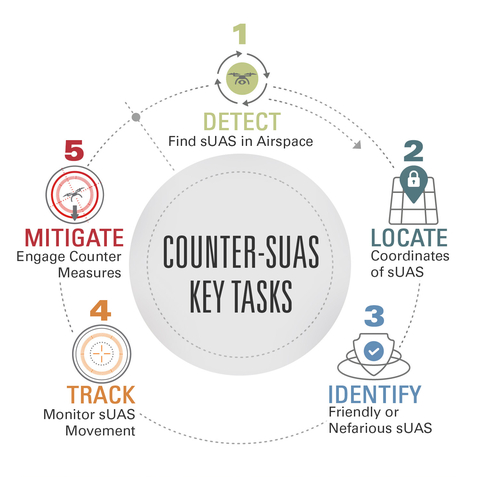As Drone Strikes Rise, Multi-Layered Approach is Crucial to Countering New and Emerging Threats
New Whitepaper from Teledyne FLIR Defense Finds Counter-Drone Solutions Must be Modular, Interoperable and Cost-Effective to Combat Growing Risks Posed by State and Non-State Actors

A new whitepaper from Teledyne FLIR Defense, ‘The Big Problem with Small Drones (and How to Address It),’ examines how governments worldwide face a growing need for flexible, tailorable, and affordable counter-drone solutions. It looks at current C-UAS strategy, identifies key challenges, and outlines the critical capabilities and factors decision-makers should consider. (Graphic: Business Wire)
In January, non-state actors from
The whitepaper, ‘The Big Problem with Small Drones (and How to Address It),’ examines how governments worldwide face a growing need for flexible, tailorable, and affordable Counter-sUAS (C-sUAS) solutions. It looks at current C-sUAS strategy, identifies key challenges, and outlines the critical capabilities governments should consider.
“There’s no ‘silver bullet’ when it comes to countering the huge risks presented by weaponized drones in the hands of bad actors,” said Dr.
“Nations around the globe are spending millions of dollars on commercially-built counter-drone solutions to address the immediate risks posed by these threats. But they need to approach the problem smartly, both from a technology and cost perspective. Our new whitepaper offers a number of insights from our team of experts,” Cullin adds.
Key findings include:
- State and non-state actors are increasingly employing military- and consumer-grade drones to attack personnel, facilities and critical infrastructure
- Counter-drone solutions must be cost effective, leveraging existing technologies through common electronic architectures and standard interfaces to ensure rapid integration of hardware and software upgrades
- Solutions must be modular, interoperable and multi-domain; easily transportable; and capable of detecting drone swarms
- Modern C-sUAS must be able to operate in contested environments where the ability to find, track, target, engage and assess threats can be disrupted by peer adversaries’ electronic warfare capabilities
- Current and future C-sUAS systems must be flexible in employing both hard kill (kinetic) and soft kill (non-kinetic) countermeasures, allowing them to operate anywhere in the world in accordance with local restrictions and rules of engagement.
As the paper sums up, ‘The threat of small drones in the wrong hands promises to remain significant for government and military decision-makers as they seek to defend forward-deployed units, airports, power grids, and other critical infrastructure. Only the deployment of mature, flexible, and cost effective C-sUAS solutions will provide the required levels in protection as this threat continues to evolve at pace.”
About Teledyne FLIR
Teledyne FLIR, a
About
View source version on businesswire.com: https://www.businesswire.com/news/home/20220308005265/en/
Teledyne FLIR Defense
+1 781-801-6161
Joe.Ailinger@teledyneflir.com
Targeted Victory
+1 617-697-9072
Ryan.Williams@targetedvictory.com
For Persian Gulf Media Inquiries:
Teledyne FLIR Defense
+1 503-830-3826
Adam.DeAngelis@teledyneflir.com
Source: Teledyne FLIR








